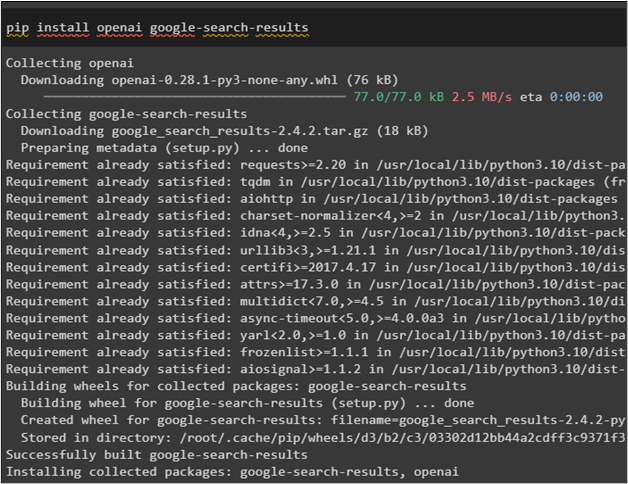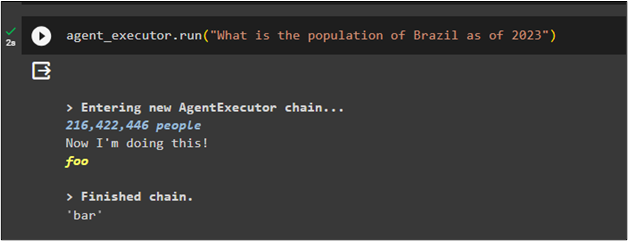Quick Outline
This post will demonstrate the following:
- How to Built Custom Multi-Action Agent in LangChain
- Installing Frameworks
- Setting up Environments
- Importing Libraries
- Configuring Random Action
- Setting up Tools
- Building Multi-Action Agent
- Designing Agent Executor
- Testing the Agent
- Conclusion
How to Built Custom Multi-Action Agent in LangChain
Agent is the tool that automates the steps and actions to complete the task of extracting information using the input string. Agents can perform multiple actions at a time like adding a signature with the displayed answer or writing some text with the answer. To learn the process of building the custom multi-action agent in LangChain, simply go through the listed steps:
Step 1: Installing Frameworks
Get started with the process of customizing the multi-action agent by installing the LangChain framework:
Also, install the openai google-search-results to build the language model for getting the answers from the internet:
Step 2: Setting up Environments
Set up the environment for the agent using the API keys from the OpenAI and SerpAPi accounts:
import getpass
os.environ["OPENAI_API_KEY"] = getpass.getpass("OpenAI API Key:")
os.environ["SERPAPI_API_KEY"] = getpass.getpass("Serpapi API Key:")
Step 3: Importing Libraries
Once the environments are set up, import the libraries using the dependencies from the LangChain framework:
from langchain.agents import AgentExecutor
from langchain.agents import BaseMultiActionAgent
from langchain.llms import OpenAI
#import library to get the google search results
from langchain.utilities import SerpAPIWrapper
Step 4: Configuring Random Action
Now, add an action that will be executed with the main action that is extracting answers to the questions given by the user:
print("\nNow I'm doing this!")
return "foo"
Step 5: Setting up Tools
Also, configure the tools for building the multi-action agent to fetch the final answers with the functions defined in the previous step:
tools = [
Tool(
name="Search",
func=search.run,
description="useful to asking queries with search tool",
),
Tool(
name="RandomWord",
func=random_word,
description="call this to get a random word",
),
]
Step 6: Building Multi-Action Agent
After setting up the tools, simply build the agent by configuring the FakeAgent() method with the BaseMultiActionAgent parameter. Also, configure the steps to perform in order to understand the questions to extract the correct answer from the internet:
from langchain.schema import AgentAction, AgentFinish
#building the agent class to explain its key responsibilities and tasks after importing the required libraries
class FakeAgent(BaseMultiActionAgent):
"""Fake Custom Agent."""
#set the input keys to building the structure of the customized agent to get started with the process
@property
def input_keys(self):
return ["input"]
#defining plan() method to make sure that it works to perform all the steps to get the required answer
def plan(
self, intermediate_steps: List[Tuple[AgentAction, str]], **kwargs: Any
) -> Union[List[AgentAction], AgentFinish]:
""" Given input, decided what to do.
#use multi-line comments to set the pathway of the steps
Args:
intermediate_steps: Tasks the Language model has performed till now,
With its observations
**kwargs: User inputs
#setting the agent when to stop generating text once the correct answer is found
Returns:
Action specifying what tool to use
"""
if len(intermediate_steps) == 0:
return [
AgentAction(tool="Search", tool_input=kwargs["input"], log=""),
AgentAction(tool="RandomWord", tool_input=kwargs["input"], log=""),
]
else:
return AgentFinish(return_values={"output": "bar"}, log="")
#usage of the objects used by the agents to tell their current status to find where the agent stands and define the asynchronous method.
async def aplan(
self, intermediate_steps: List[Tuple[AgentAction, str]], **kwargs: Any
) -> Union[List[AgentAction], AgentFinish]:
""" Given input, decided what to do
#use multi-line comments to set the pathway of the steps
Args:
intermediate_steps: Tasks the Language model has performed till now,
With its observations
**kwargs: User inputs
#setting the agent when to stop generating text once the correct answer is found
Returns:
Action specifying what tool to use
"""
if len(intermediate_steps) == 0:
return [
AgentAction(tool="Search", tool_input=kwargs["input"], log=""),
AgentAction(tool="RandomWord", tool_input=kwargs["input"], log=""),
]
else:
return AgentFinish(return_values={"output": "bar"}, log="")
Step 7: Designing Agent Executor
After configuring the agent, define the agent variable using the FakeAgent() method containing all the configurations:
Design the AgentExecutor to run the agent using the agent, tools, and verbose arguments:
agent=agent, tools=tools, verbose=True
)
Step 8: Testing the Agent
Simply test the agent to check if it performs both tasks like answering the following question by printing the lines defined in the random_word() method:
The following screenshot displays that the agent has extracted the answer and prints the line by calling the random_work() method:
That’s all about building the custom multi-action agent in LangChain.
Conclusion
To build the custom multi-action agent in LangChain, simply install the modules to get the dependencies for importing the libraries. Use the libraries to set up the tools for searching data from the internet and calling the random_word() function at the same time. After that, simply test the agent by defining the AgentExecutor() method to run the multi-action agent in LangChain. This guide has elaborated on the process of building the custom multi-action agent in LangChain.






